Classification of fruits
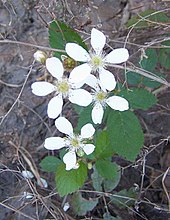 Dewberry flowers. Note the multiple pistils, each of which will produce a drupelet. Each flower will become a blackberry-like aggregate fruit.
Dewberry flowers. Note the multiple pistils, each of which will produce a drupelet. Each flower will become a blackberry-like aggregate fruit. 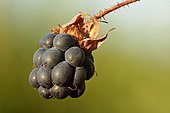 Dewberry fruit
Dewberry fruit Consistent with the three modes of fruit development, plant scientists have classified fruits into three main groups: simple fruits, aggregate fruits, and multiple (or composite) fruits.[14] The groupings reflect how the ovary and other flower organs are arranged and how the fruits develop, but they are not evolutionarily relevant as diverse plant taxa may be in the same group.
While the section of a fungus that produces spores is called a fruiting body,[15] fungi are members of the fungi kingdom and not of the plant kingdom.
Simple fruits
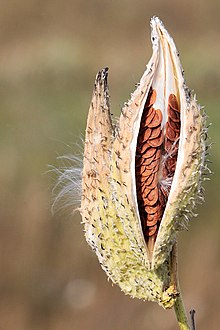 A dry simple fruit: milkweed (Asclepias syriaca); dehiscence of the follicular fruit reveals seeds within.
A dry simple fruit: milkweed (Asclepias syriaca); dehiscence of the follicular fruit reveals seeds within. Simple fruits are the result of the ripening-to-fruit of a simple or compound ovary in a single flower with a single pistil. In contrast, a single flower with numerous pistils typically produces an aggregate fruit; and the merging of several flowers, or a 'multiple' of flowers, results in a 'multiple' fruit.[16] A simple fruit is further classified as either dry or fleshy.
To distribute their seeds, dry fruits may split open and discharge their seeds to the winds, which is called dehiscence.[17] Or the distribution process may rely upon the decay and degradation of the fruit to expose the seeds; or it may rely upon the eating of fruit and excreting of seeds by frugivores – both are called indehiscence. Fleshy fruits do not split open, but they also are indehiscent and they may also rely on frugivores for distribution of their seeds. Typically, the entire outer layer of the ovary wall ripens into a potentially edible pericarp.
Types of dry simple fruits, (with examples) include:
- Achene – most commonly seen in aggregate fruits (e.g., strawberry, see below).
- Capsule – (Brazil nut: botanically, it is not a nut).
- Caryopsis – (cereal grains, including wheat, rice, oats, barley).
- Cypsela – an achene-like fruit derived from the individual florets in a capitulum: (dandelion).
- Fibrous drupe – (coconut, walnut: botanically, neither is a true nut.).
- Follicle – follicles are formed from a single carpel, and opens by one suture: (milkweed); also commonly seen in aggregate fruits: (magnolia, peony).
- Legume – (bean, pea, peanut: botanically, the peanut is the seed of a legume, not a nut).
- Loment – a type of indehiscent legume: (sweet vetch or wild potato).
- Nut – (beechnut, hazelnut, acorn (of the oak): botanically, these are true nuts).
- Samara – (ash, elm, maple key).
- Schizocarp, see below – (carrot seed).
- Silique – (radish seed).
- Silicle – (shepherd's purse).
- Utricle – (beet, Rumex).
Fruits in which part or all of the pericarp (fruit wall) is fleshy at maturity are termed fleshy simple fruits.
Types of fleshy simple fruits, (with examples) include:
- Berry – the berry is the most common type of fleshy fruit. The entire outer layer of the ovary wall ripens into a potentially edible "pericarp", (see below).
- Stone fruit or drupe – the definitive characteristic of a drupe is the hard, "lignified" stone (sometimes called the "pit"). It is derived from the ovary wall of the flower: apricot, cherry, olive, peach, plum, mango.
- Pome – the pome fruits: apples, pears, rosehips, saskatoon berry, etc., are a syncarpous (fused) fleshy fruit, a simple fruit, developing from a half-inferior ovary.[18] Pomes are of the family Rosaceae.
Berries
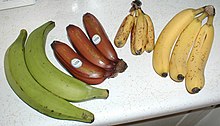 Fruits of four different banana cultivars (Bananas are berries.)
Fruits of four different banana cultivars (Bananas are berries.) 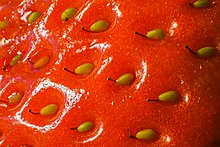 Strawberry, showing achenes attached to surface. Botanically, strawberries are not berries; they are classified as an aggregate accessory fruit.
Strawberry, showing achenes attached to surface. Botanically, strawberries are not berries; they are classified as an aggregate accessory fruit.  Flower of Magnolia × wieseneri showing the many pistils making up the gynoecium in the middle of the flower. The fruit of this flower is an aggregation of follicles.
Flower of Magnolia × wieseneri showing the many pistils making up the gynoecium in the middle of the flower. The fruit of this flower is an aggregation of follicles. Berries are a type of simple fleshy fruit that issue from a single ovary.[19] (The ovary itself may be compound, with several carpels.) The botanical term true berry includes grapes, currants, cucumbers, eggplants (aubergines), tomatoes, chili peppers, and bananas, but excludes certain fruits that are called "-berry" by culinary custom or by common usage of the term – such as strawberries and raspberries. Berries may be formed from one or more carpels (i.e., from the simple or compound ovary) from the same, single flower. Seeds typically are embedded in the fleshy interior of the ovary.
Examples include:
- Tomato – in culinary terms, the tomato is regarded as a vegetable, but it is botanically classified as a fruit and a berry.[20]
- Banana – the fruit has been described as a "leathery berry".[21] In cultivated varieties, the seeds are diminished nearly to non-existence.
- Pepo – berries with skin that is hardened: cucurbits, including gourds, squash, melons.
- Hesperidium – berries with a rind and a juicy interior: most citrus fruit.
- Cranberry, gooseberry, redcurrant, grape.
The strawberry, regardless of its appearance, is classified as a dry, not a fleshy fruit. Botanically, it is not a berry; it is an aggregate-accessory fruit, the latter term meaning the fleshy part is derived not from the plant's ovaries but from the receptacle that holds the ovaries.[22] Numerous dry achenes are attached to the outside of the fruit-flesh; they appear to be seeds but each is actually an ovary of a flower, with a seed inside.[22]
Schizocarps are dry fruits, though some appear to be fleshy. They originate from syncarpous ovaries but do not actually dehisce; rather, they split into segments with one or more seeds. They include a number of different forms from a wide range of families, including carrot, parsnip, parsley, cumin.[14]
Aggregate fruits
You received this message because you are subscribed to the Google Groups "1top-oldtattoo-1" group.
To unsubscribe from this group and stop receiving emails from it, send an email to 1top-oldtattoo-1+unsubscribe@googlegroups.com.
To view this discussion on the web visit https://groups.google.com/d/msgid/1top-oldtattoo-1/CAGNPKmkx34b46YjGNbCiJ0W7cAGksY%3DO6AVHZ2o%3DaX4%3DWvVQCQ%40mail.gmail.com.

No comments:
Post a Comment